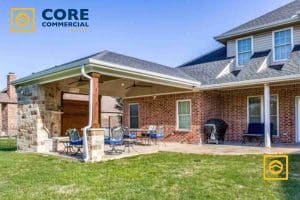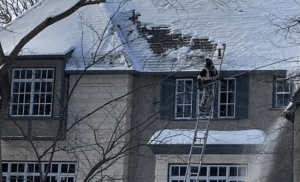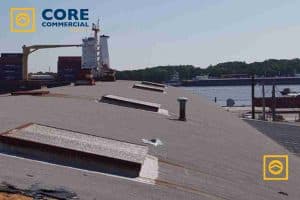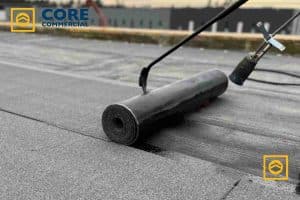Investing in a commercial re-roof is a major step toward protecting your building and ensuring long-term value. But the job isn’t finished once the new roof is installed. Many property owners in Texas overlook the importance of post-installation care, leading to premature wear, unexpected leaks, and costly repairs. This article covers seven essential maintenance tips tailored for Texas property owners to help you extend your new roof’s life, protect your investment, and avoid expensive problems down the road. Whether you manage an office park in Austin, a warehouse in Houston, or a retail center in Dallas, these practical tips will guide you through proactive steps that make your re-roof worth every dollar.
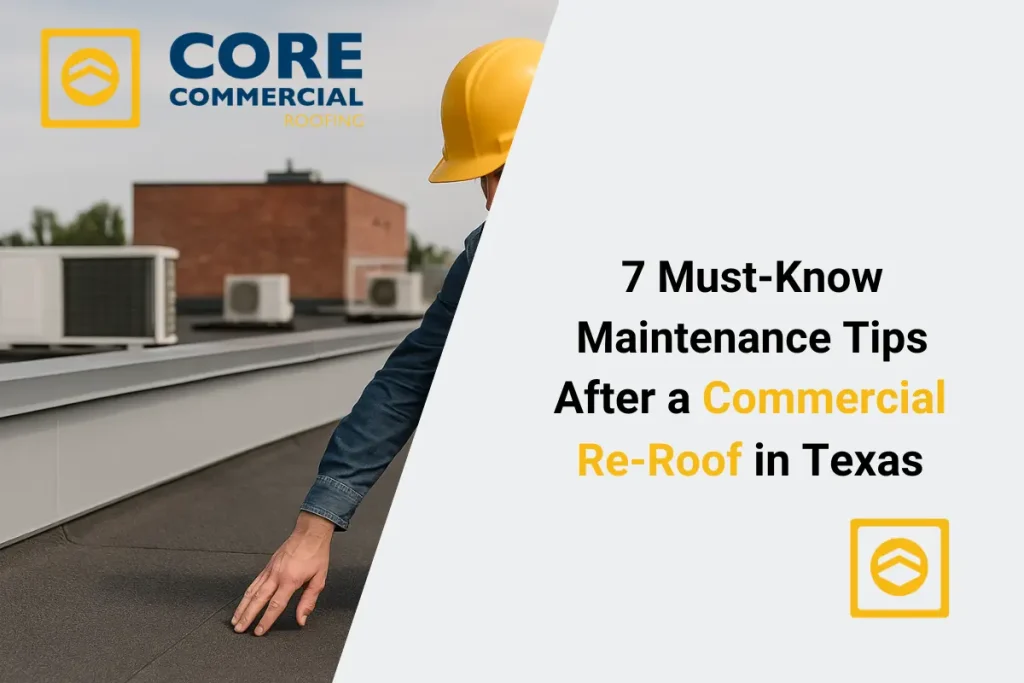
Table of Contents
Inspect Your Roof After Extreme Texas Weather
Why it matters:
Texas weather is no joke. From hailstorms in Fort Worth to hurricane winds along the Gulf Coast, your commercial roof gets tested hard and fast. Even a brand-new roof can suffer damage from high winds, hail, or flying debris.
What to do:
After any major storm — especially those with hail, high wind, or heavy rainfall — inspect your roof or have a professional do it for you. Look for:
- Missing or lifted flashing
- Dented or punctured membrane
- Pooling water in flat sections
- Damaged HVAC equipment
Benefits:
Early detection helps prevent leaks, mold, and insulation damage. Fixing minor issues quickly saves thousands in future repairs and protects your building from water intrusion.
Schedule Professional Inspections Twice a Year
Why it matters:
Even without storms, commercial roofs in Texas take a beating from extreme sun, UV rays, and temperature swings — all of which can speed up wear and tear.
What to do:
Have a licensed commercial roofer inspect your roof every spring and fall. These seasons are ideal because they follow Texas’s intense summer heat and potential winter freezes. Professional inspections often include:
- Checking seams, edges, and penetrations
- Testing drainage performance
- Looking for early signs of membrane shrinkage or blistering
- Evaluating flashing and sealant conditions
Benefits:
Bi-annual inspections help spot issues you might miss, giving you time to act before they snowball. This habit can extend your roof’s life by 5–10 years.
Keep Gutters and Drains Clean
Why it matters:
Clogged gutters and rooftop drains are silent roof killers. They cause water to back up and sit on the roof’s surface, leading to premature wear and leaks.
What to do:
In Texas, especially during spring pollen seasons and autumn leaf fall, clean your gutters and rooftop drains at least once per quarter. Check:
- Gutter runs for leaves, sticks, and sediment buildup
- Drain screens and scuppers for obstructions
- Downspouts for blockages
Benefits:
Clear drainage systems prevent ponding water, mold growth, and damage to roofing membranes. This simple habit ensures your roof continues to function as designed.
You may try : best commercial roofing company
Address Minor Repairs Immediately
Why it matters:
Small problems grow fast in the Texas climate. One loose fastener or cracked sealant joint can let water in, ruin insulation, and compromise the structural integrity of your roof deck.
What to do:
Act fast on:
- Punctures from HVAC maintenance
- Cracks in flashing
- Open seams
- Missing screws or deteriorating caulk
Use your inspection reports to follow up with necessary fixes. Even if a problem looks minor, bring in a qualified commercial roofer — they can verify whether it’s harmless or a leak waiting to happen.
Benefits:
You avoid interior damage, insurance claims, and long-term rot by catching and fixing issues early.
Trim Overhanging Trees and Vegetation
Why it matters:
Branches can rub and puncture the roof membrane over time, and falling leaves clog up your drainage system. Plus, tree limbs can break during storms and cause serious roof damage.
What to do:
Survey the perimeter of your commercial property and trim any overhanging branches at least 3–5 feet away from your roof. Hire a tree professional if needed, especially for high or hard-to-reach limbs.
Benefits:
Keeps debris off your roof, extends membrane life, and reduces the risk of storm-related damage. It also makes inspections and repairs safer and easier.
Keep Maintenance Records and Warranties Organized
Why it matters:
When something goes wrong, your documentation can be your best defense. Roofing warranties in Texas often require proof of regular maintenance for claims to be valid.
What to do:
Maintain a physical and digital record of:
- Inspection reports
- Repair invoices
- Photos before and after work
- Dates of storm events
- Roof warranty documents
Also note who performed any work, including name, license number, and contact info.
Benefits:
You’ll be ready for insurance adjusters, warranty claims, and property resale negotiations. Staying organized ensures faster response and reduces headaches during emergencies.
Learn now: commercial roofing price per square
Set Up a Preventive Maintenance Plan
Why it matters:
A re-roof is not a one-and-done solution. Without ongoing care, even the best installation won’t last its full life expectancy — especially under Texas’s harsh sun and weather patterns.
What to do:
Work with a local commercial roofing contractor to build a customized preventive maintenance plan. A solid plan includes:
- Regular inspections
- Proactive small repairs
- Seasonal cleaning
- Scheduled roof reports for building owners or property managers
If your property is part of a commercial portfolio or managed by a facilities team, this plan helps streamline oversight and budgeting.
Benefits:
Maximizes the return on your re-roof investment, prevents unplanned downtime, and keeps tenants and clients safe and dry. Preventive maintenance also keeps your property in compliance with Texas building codes and insurance standards.
Final Thoughts: Take Control of Your Roof’s Long-Term Health
A commercial re-roof is a major milestone — but it’s only the beginning. What you do after the new roof goes on makes the biggest difference in how long it lasts and how well it performs.
Texas property owners face unique challenges: blazing summers, violent storms, and heavy seasonal debris. With these 7 must-know maintenance tips, you’ll stay ahead of roof damage, protect your investment, and ensure long-term peace of mind.
Taking a proactive approach means fewer emergencies, lower repair costs, and a safer, drier building — for decades to come.
FAQs
When should I inspect my commercial building’s roof in Texas?
It’s recommended to inspect your commercial roof at least twice a year, typically in the spring and fall. Additionally, after severe weather events like hailstorms or hurricanes, an immediate inspection is crucial to identify and address any potential damage early.
What are signs my commercial roof needs maintenance?
Common signs include water stains on ceilings, visible leaks, pooling water on the roof, cracked or blistered roofing materials, and sagging areas. Regular inspections can help detect these issues before they escalate.
How often should commercial gutters be cleaned in Texas?
Gutters should be cleaned at least twice a year, in the spring and fall. However, if your building is surrounded by trees or experiences frequent storms, more frequent cleaning may be necessary to prevent clogs and water damage.
What is a preventive maintenance plan for commercial roofs?
A preventive maintenance plan involves regular inspections, timely repairs, and routine cleaning to extend the lifespan of your roof. It helps in early detection of issues, reducing repair costs, and ensuring the roof remains in optimal condition.
Why is it important to trim trees near my commercial roof?
Overhanging branches can damage the roof surface, especially during storms. Falling leaves and debris can clog gutters, leading to water pooling and potential leaks. Regular trimming helps prevent these issues.
How can I extend the lifespan of my commercial roof in Texas?
Regular inspections, prompt repairs, proper drainage maintenance, and protective coatings can significantly extend your roof’s lifespan. Addressing minor issues promptly prevents major problems and costly replacements.
What should be included in a commercial roof maintenance checklist?
A comprehensive checklist should cover inspection of roofing materials, flashing, gutters, drainage systems, and signs of wear or damage. It should also include cleaning schedules and documentation of repairs.
What impact does Texas weather have on commercial roofing?
Texas weather, characterized by intense sun, heavy rains, and occasional hailstorms, can accelerate roof wear and tear. UV radiation can degrade materials, while storms can cause physical damage, making regular maintenance essential.
What are the benefits of regular commercial roof maintenance?
Regular maintenance helps in early detection of issues, reduces repair costs, extends the roof’s lifespan, ensures safety, and maintains energy efficiency. It also helps in compliance with warranty requirements.
Can I perform commercial roof maintenance myself?
While basic visual inspections can be done, it’s advisable to hire professionals for thorough inspections and repairs. They have the expertise and equipment to safely and effectively maintain your roof.



